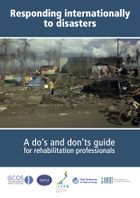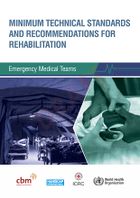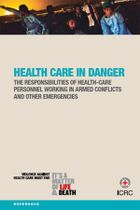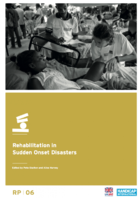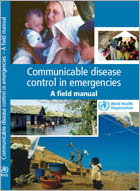Management of Traumatic Brain Injury in Disaster Situations
Original Editor - Naomi O'Reilly
Top Contributors - Naomi O'Reilly, Kim Jackson, Rachael Lowe, Tony Lowe, Jess Bell and Admin
Introduction[edit | edit source]
Disaster, as defined by the United Nations, is a serious disruption of the functioning of a community or society, which involve widespread human, material, economic or environmental impacts that exceed the ability of the affected community or society to cope using its own resources.[1] According to the International Federation of Red Cross & Red Crescent Societies a disaster occurs when a hazard impacts on vulnerable people. The combination of hazards, vulnerability and inability to reduce the potential negative consequences of risk results in the disaster. [2] While disasters can be caused by nature, the human influence on disasters have been widespread throughout the centuries, particularly in relation to conflict situations. Natural disasters and armed conflict are two of the main types of disasters and have marked human existence throughout history resulting in peaks in mortality and morbidity. [3] Find out more about the different types of disasters and disaster management.
While accurate data is scarce, traumatic brain injury remains a common neurological consequence of disasters, natural and man made. A wide range of mild, moderate, and severe traumatic brain injury occur secondary to overpressure, penetrating wounds, and crush injuries following the huge kinetic energy released by rapid-onset natural disasters. Disaster preparedness planners and emergency medical personnel face a major challenge in preventing and managing neurotrauma within this context. As with any traumatic brian injury, management is complex and individuals often have long-term physical, cognitive and behavioural impairments with residual neurological deficits, medical complications all resulting in lifestyle consequences, which necessitate comprehensive interdisciplinary management, including medical, surgical and rehabilitation. [4]
Immediate Emergency Care[edit | edit source]
Early diagnosis and treatment of traumatic brain injuries can be challenging under normal circumstances, but are further exacerbated in the aftermath of disaster due to to the chaotic environment including damaged infrastructure, poor communication and shortages of relevant health and rehabilitation workers, particularly neurotrauma specialists. [5]
During this early stage, immediate diagnosis and treatment remains key to minimise the development of secondary brain injuries, which is a massive challenge, particularly in developing countries where medical infrastructure and availability of state-of-the-art neurological care is already scare and may be further limited as a result of the disaster. Families are often separated, and symptoms of posttraumatic stress disorder can be common during the postacute phase.
As a result, early deployment of specialised emergency medical teams to meet the immediate needs of disaster victims is a key element of the immediate emergency response, and is guided by a range of World Health Organization initiatives, including Emergency Response Frameworks (Standards and Guidelines); Coordination Mechanisms, Emergency Medical Team Accreditation Process ensuring that rehabilitation professionals form part of the Emergency Medical Teams. [5]
Specialized care teams are defined by the World Health Organization as “national or international teams embedded into Emergency Medical Teams or a national facility to provide specialist care”, which may include rehabilitation teams and are deployed based on the response to meet specific needs required at the request of the host health authorities. These teams should be multidisciplinary and need to be integrated into a disaster response and management plan and their skills need to be shared with local rehabilitation and health-care providers through mentoring and educating/training." [4]
A specialised care team that is focused on traumatic brain injury rehabilitation should;
| Rehabilitation Interventions | General Applicability of Recommendations in Disaster Settings | |
|---|---|---|
| Weak | ||
| Team Composition | Minimum Technical Standard;
A traumatic brian injury specialised rehabilitation team should be led by a rehabilitation physician and comprise of at least three other professionals from different disciplines, including rehabilitation medicine, nursing, physiotherapy, occupational therapy, speech and language therapy, and psychology. In addition, a team lead is required to represent the care team at health coordination level | |
| Qualification and Experience | Minimum Technical Standard;
Rehabilitation professionals in a traumatic brian injury specialised care team should have at least 6 months’ experience working in a traumatic brain injury unit or with traumatic brain injury patients in a major trauma center and at least 3 years of postqualifying clinical experience At least one team member, preferable the team leader, should have experience in emergency response and all team members should have undergone training in working in austere environments | |
| Rehabilitation Equipment | Minimum Technical Standard;
Specialized care teams for rehabilitation should have capability to rapidly provide the equipment listed in | |
| Length of Stay | Minimum Technical Standard;
A team that embeds into a local facility should plan to stay for at least 1 month with evidence of a exist strategy and release mechanism | |
Rehabilitation[edit | edit source]
The overriding objective of traumatic brain injury care in disaster settings has now extended well beyond survival and acute management to successful implementation of rehabilitation structures to work towards reintegration of the individual with a traumatic brain injury back into home and community. The World Health Organization minimum standards for rehabilitation recommendations for managing patients with traumatic brian injury following a disasters inlude; [4][6]
- Cognitive and Neurological changes should be monitored and regularly assessed
- Early referral to a step-down facility using local rehabilitation providers and support networks, as required
- Appropriate mobility aids prescribed for long-term mobility deficits using local service provider
- Patients with long term or permanent nerve injury considered for orthotic device, sought from a local provider
- Referral pathways identified for microsurgery for appropriate patients
Rehabilitation is a vital element of the treatment and management process post traumatic brain injury in a disaster setting and should prepare individuals with long-term impairment, their care providers and local rehabilitation personnel to manage their ongoing needs over a longer term and should be started early following any disaster.[6] The goal of rehabilitation in a disaster setting is to improve functional outcomes, minimize secondary complications, and successful reintegration into the community, with an emphasis on patient and care giver education and self-management.
Role of the Physiotherapist[edit | edit source]
Physiotherapists intitally involved in disaster settings, were physiotherapists employed in military service including the United States and British Armed Forces, whose primary role involved triage in disaster settings including acute orthopaedic trauma, wound care, as well as respiratory care in critical settings. Despite the range of roles these physiotherapists and others have provided in disasters situations, many disaster response organizers and physiotherapists did not know how to use their skills to provide maximum effect as a result of a lack of clearly defined roles for physiotherapists within emergency reponse teams in disaster settings.
While historiclly not routinely included in immediate post disaster emergency medical teams, physiotherapists are now starting to be recognised for the role they can play in disaster response following discussions between the World Confederation for Physical Therapy and physiotherapists involved in humanitarian responses who identified a need to advocate for the presence of rehabilitation professionals, including physiotherapists, in all phases of disaster management and to affirm the need for the establishment or development of physiotherapy services in disaster settings through strengthening of our role in preparedness and promotion of our role within emergency medical teams.
According to Pete Skelton, Physiotherapist and Rehabilitation Project Manager at Humanity and Inclusion and UK International Emergency Trauma Register member, ‘Physiotherapy is starting to become a central part of global humanitarian response... and we play a critical role, which goes way beyond just rehabilitation. The role of physios in emergency situations differs significantly depending on the context. We may find ourselves working in a field hospital providing acute surgical care, working on an outpatient basis, providing care in people’s homes or providing prosthetic provision in a temporary clinic.’
Humanity & Inclusion has played a huge role in working towards integration of rehabilitation rehabilitation into the UK Emergency Medical Team, which has involved the recruitment and training of rehabilitation professionals to join the teams, and working with partner organisations to ensure the field hospital is fully equipped and accessible with all relevant equipment required by rehabilitation professionals. This has enabled early access to rehabilitation including the provision of essential equipment such as wheelchairs and orthotics, psychosocial support, and onward referral. The following resources have also been developed to support this;
- Clinical Manual on Rehabilitation in Disasters,
- Briefing Paper on Disaster Management for Physiotherapists
- "Do's and Don’ts" Guide for Rehabilitation Professionals Responding to Disasters
- Emergency Medical Teams: WHO Minimum Technical Standards and Recommendations for Rehabilitation
Role in Preparation Phase[edit | edit source]
Role in Response Phase[edit | edit source]
Growing evidence supports the role that rehabilitation, including physiotherapy, should be considered a central part of disaster response from the onset of a disaster with physiotherapists involved not only in direct provision of rehabilitation, but also involved in assessment, coordination, psycho-social support and advocacy.Their work was helping the Doctors and Nurses. They were cleaning wound, Dressing and first aid to the victims. Physiotherapists also helped them in assessment of injury and doing first referral to Orthopaedic surgeons.Two of them gave breathing exercises to reduce work of breathing.Teaching the patient ambulation and walking aids.Taking care of the patients with Spinal cord injury, Amputation other injuries.Preparing the assessment and planning physiotherapy treatment.Taking care of already disable persons before Disaster.
Role in Recovery Phase[edit | edit source]
Two of Physiotherapists are still working in Recovery stage.They are treating and rehabilitating patients with SCI, Amputation and other multiple injuries. Preparing patient for their occupation.Have helping them to regain independent mobility.
Guidelines[edit | edit source]
Independently extracted, compared, and categorized evidence-based rehabilitation intervention recommendations for rehabilitation interventions were synthesized from currently published traumatic brian injury Clinical Practice Guidelines, developed by the Department of Labor and Employment (DLE); Scottish Intercollegiate Guidelines Network (SIGN); Department of Veterans Affairs/Department of Defence (DVA/DOD); and American Occupational Therapy Association (AOTA) for applicability in disaster settings. [6]
As a result of the complexities related to the environment, resources, service provision, and workforce in disasters settings many recommendations for traumatic brain injury care are challenging to implement and more advanced interventions are generally not applicable due to limited access to services, trained staff/resources, equipment, funding, and operational issues.[6]
Patient/carer education, general physical therapy, practice in daily living activities and safe equipment use, direct cognitive/behavioral feedback, basic compensatory memory/visual strategies, basic swallowing/communication, and psychological input are the key recommendations from a rehabilitation perspective that have been fond to be most applicable for survivors of traumatic brain injury in disaster settings. The following table outlines the general applicability of clinical practice guildeines for traumatic brain injyry in disaster settings.[6]
| Rehabilitation Interventions | General Applicability of Recommendations in Disaster Settings | ||
|---|---|---|---|
| Weak | Moderate | Strong | |
| Patient Education |
| ||
| Gait, Balance and Mobility |
|
Task-Specific Training
Repetitive Training |
|
| Spasticity and Muscle Tone |
|
|
|
| Sleep Disturbance Management |
| ||
| Cognitive Rehabilitation |
|
|
|
| Behavioural and Emotional Disorders |
|
Comprehensive Neurobehavioural Program
|
|
| Activities of Daily Living |
|
|
|
| Post-Traumatic Headache Management |
|
| |
| Service Delivery |
|
|
|
Responding Internationally to Disasters: Do’s and Don’ts
When disasters strike, there is always a huge amount of goodwill from rehabilitation professionals around the world who wish to use their skills to support those affected. This brief guidance informs those who are considering responding internationally to a disaster either as individuals or as part of a team. It highlights key questions to consider before departing, whilst working in the disaster area, and on returning home. Responses to these questions considered are presented as “Do’s and Don’ts” which are exempli ed by recommended practices and those to avoid in the real case studies below. The guidance note is not intended to be a step-by-step or technical guide, nor is it exhaustive, and does not supersede any specific guidance provided by your own global professional body.
Minimum Technical Standards and Recommendations for Rehabilitation: Emergency Medical Teams
This document is the result of collaboration between a working group of rehabilitation experts convened by the World Health Organization and external consultations. It is thus based on a collective experience in rehabilitation during responses to recent large-scale emergencies and also on published data. In time, the minimum standards for rehabilitation in emergencies will be part of a broader series of publications based on the Classification and Minimum Standards for Foreign Medical Teams in Sudden Onset Disaster. The purpose of this document is to extend these standards for physical rehabilitation and provide guidance to Emergency Medical Teams (EMTs) on building or strengthening their capacity for and work in rehabilitation within defined coordination mechanisms.
Rehabilitation in Sudden Onset Disasters
The role of rehabilitation professionals in responding to sudden onset disasters, such as earthquakes or tsunamis, is evolving rapidly, and they increasingly find themselves at the forefront of emergency response teams. This manual is designed for Physiotherapists and Occupational Therapists who provide rehabilitation in the immediate aftermath of a sudden onset disaster. It was developed to support volunteers on the UK International Emergency Trauma Register, but with the aim of being relevant to all rehabilitation professionals interested in rapid deployment to austere environments.
Communicable Disease Control in Emergencies - A Field Manual
This manual is intended to help health professionals and public health coordinators working in emergency situations prevent, detect and control the major communicable diseases encountered by affected populations.
Resources[edit | edit source]
International Society of Physical and Rehabilitation Medicine: Disaster Rehabilitation Committee - Role and future agenda Sept 2018
Centers for Disease Control and Prevention, Brain Injuries and Disaster Events Information for Clinicians - List of useful organisations and links
Lee SY, Amatya B, Judson R, Truesdale M, Reinhardt JD, Uddin T, Xiong XH, Khan F. Applicability of traumatic brain injury rehabilitation interventions in natural disaster settings. Brain injury. 2019 Aug 24;33(10):1293-8.
"Many recommendations for TBI care are challenging to implement in disaster settings due to complexities related to the environment, resources, service provision, workforce, and other reasons"
Amatya B, Vasudevan V, Zhang N, Chopra S, Astrakhantseva I, Khan F. Minimum technical standards and recommendations for traumatic brain injury rehabilitation teams in sudden-onset disasters. The Journal of the International Society of Physical and Rehabilitation Medicine. 2018 Apr 1;1(2):72.
"Specialized rehabilitation teams in any disasters are deployed based on the response to meet specific needs required at the request of the host health authorities. These teams should be multidisciplinary and need to be integrated into a disaster response and management plan and their skills need to be shared with local rehabilitation and health-care providers through mentoring and educating/training."
Vasudevan V, Amatya B, Chopra S, Zhang N, Astrakhantseva I, Khan F. Minimum technical standards and recommendations for traumatic brain injury specialist rehabilitation teams in sudden-onset disasters (for Disaster Rehabilitation Committee special session). Annals of Physical and Rehabilitation Medicine. 2018 Jul 1;61:e120.
Regens JL, Mould N. Prevention and treatment of traumatic brain injury due to rapid-onset natural disasters. Frontiers in public health. 2014 Apr 14;2:28
Battlefield and Disaster Nursing Pocket Guide, Ed. by Elizabeth Bridges. Jones & Bartlett, 2009 - guidelines for managing mild through to severe TBI injuries
Veenema TG, editor. Disaster nursing and emergency preparedness. Springer Publishing Company; 2018 Jul 28.
Military Acute Concussion Evaluation 2 (MACE 2)
3 question DVBIC TBI screening tool
Joint Trauma System Clinical Practice Guideline: Neurosurgery and Severe Head Injury (CPG ID:30), Mar 2017
References[edit | edit source]
References will automatically be added here, see adding references tutorial.
- ↑ United Nations Office for Disaster Risk Reduction. Terminology. http://www.unisdr.org/we/inform/terminology#letter-p [Accessed 29 Sep 2019]
- ↑ International Federation of Red Cross and Red Crescent Societies. What is a Disaster. http://www.ifrc.org/en/what-we-do/disaster-management/about-disasters/what-is-a-disaster/. [Accessed: 9 Jan 2017]
- ↑ Leaning J, Guha-Sapir D. Natural Disasters, Armed Conflict, and Public Health. New England Journal of Medicine. 2013 Nov 7;369(19):1836-42
- ↑ 4.0 4.1 4.2 Amatya B, Vasudevan V, Zhang N, Chopra S, Astrakhantseva I, Khan F. Minimum technical standards and recommendations for traumatic brain injury rehabilitation teams in sudden-onset disasters. The Journal of the International Society of Physical and Rehabilitation Medicine. 2018 Apr 1;1(2):72.
- ↑ 5.0 5.1 Regens JL, Mould N. Prevention and treatment of traumatic brain injury due to rapid-onset natural disasters. Frontiers in public health. 2014 Apr 14;2:28.
- ↑ 6.0 6.1 6.2 6.3 6.4 Lee SY, Amatya B, Judson R, Truesdale M, Reinhardt JD, Uddin T, Xiong XH, Khan F. Applicability of traumatic brain injury rehabilitation interventions in natural disaster settings. Brain injury. 2019 Aug 24;33(10):1293-8. DOI: 10.1080/02699052.2019.1641748
